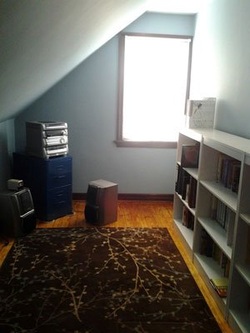 There are lots of design resources on the world wide web. Recently I read a designer's response to a question asked by a homeowner. As an educated designer I find it discouraging that many of the question and answer formats ignore evidence based design elements and principles. The homeowner wrote a lengthy description of an upstair room: the room was just painted, did not want to repaint, and wanted the space to not feel like a cave. (image left) The questions included: Is there anything I can do to make the room brighter without changing the wall color? Should I get more white pieces? One friend suggested a glass desk? Good idea? I was also thinking about adding some orange accents. Would that help or make it worse? The "designer" response was weak, avoided some of the questions, and spent much time suggesting purchases without explanation as to why. The designer response: “I say paint. The reader sounds like a person with an adventuresome spirit and this wall color is rather gloomy. If she is feeling brave, she can consider a rich navy or charcoal accented with a little splash of orange she mentions. Don’t be afraid of the dark! Keep the plastic shelves and paint the window trim the same white. Add a tall, sculptural floor lamp to provide some height and light at the end of the room. She might try something like the Dudero floor lamp from Ikea. She can place a desk below the sloped wall. The idea of a one with a glass top would add sparkle to the room or the Go-Cart desk from CB2 in chartreuse or this year’s go-to-blue would add another splash of color. CB2 has a nice selection of bright desk chairs to top off the deal. A task lamp on the desk will help balance the light in the room and help her to see to pay the bills.Keep the window covering white and as minimal as her privacy standards permit. One of the wonderful rugs from FLOR will crown the graphic concept. Look at “Fuzzy Button” or “Sprial Out." Don’t think 'cave.' Think rich color and crisp accents. I want to visit her when it is finished. Easy-breezy.” This response suggests that the designer did not listen to the client's concerns and questions. This designer simply redesigned the room according to his/her personal preferences. The designer walked all over and ignored the homeowner's personal preference of not wanting a dark room. A good designer is one who does not leave a personal mark on a client's space just a well designed room. As a client you should expect a designer to listen to you, read your personal styling, and understand your lifestyle. This vetting process would then mix the client's personal taste with the elements and principles of design AND the tenants of environmental and color psychology. Any response short of this design methodology is just a personal opinion, not professional advice. Listen carefully to the difference.... My response to this homeowner's dilemma - repeating the questions and drawing a conclusion. Is there anything I can do to make the room brighter without changing the wall color? The light blue wall color reflects close to 80% of the light that shines on it. This is good for creating a visually larger space. Blue compliments the orange floor because these colors are opposite on the color wheel. Blue is not the issue. Blue is obviously your personal preference - that's why you chose it. No need to repaint the walls to get out of the cave. Should I get more white pieces? No need for more white furniture. Instead, the slanted wall should be painted white to make it part of the ceiling - this will add vertical height to the room. Keep the eye up! White reflects 100% of the light and this adds to the brightness needed in a cave. And, painting the slanted wall white is less costly than buying more furniture. More furniture will only tighten up the space. One friend suggested a glass desk? Good idea? Yes, a good idea. A glass desk would not minimize the space, will not add to the visual disturbance, and will not affect the color palette. The size of the desk should be proportionate to the space. Just because it is glass does not mean you can go big. Add an appropriate sized yet functional lamp on the far side of the desk - carries the eye farther into the room. I was also thinking about adding some orange accents. Would that help or make it worse? First, let’s talk about the palette already in the room - blue walls and orange floors. Blue and orange are opposite on the color wheel and therefore cannot be processed simultaneously by the eye. This creates a higher level of energy in the space - something you may not have initially intended - but the floor is there and you already chose the blue so let’s move on. Second, there is another color in the room that needs to be addressed. The rug color, despite being analogous to the orange floor, is pulling the eye down. The dark red is absorbing close to 97% of the light that strikes it. The huge light reflective variation between the dark red and the light blue creates a disconnect that enhances the fact that this is a small space - the eye is forced to look down. If you want to 'feel more space' you must keep the eye up, up, and up. Remove the dark rug. Third, adding orange accents will create a higher energy for reason stated earlier. Depending on the amount, location, and size of orange objects in the room you can add "fun" without making the space smaller. If you give your eye too many different colors and objects to process you will shrink your room. Understand this formula: increased variances = greater visual disturbance = smaller feeling room. Conclusion: Color is the first thing the eye perceives, followed by contrast. In small spaces keep the palette small. Minimize the amount of visual disturbance in the room. You have blue walls and orange floors. That is your palette. Take out the red rug. With the odd shape of the room you may have to create a rug. Buy a piece of painter’s canvas from the hardware store. Cut it proportionate to the room - much longer than wide. This will draw the eye to the window at the farthest end of the room - important concept in small spaces and a way finding strategy. Paint a large scale orange graphic design on the canvas with a tiny bit of blue, i.e., large orange daisies with blue centers. The large scaled design will fool the eye in a small space - a quirky but affective contrast. Get a small glass desk, an orange chair to carry the eye up, and to the left of the window hang a piece of art (to fit space) containing a lot of orange, maybe some blue, and certainly of bit of natural green. Something like this apple green & orange image. Or, create a window dressing using the same graphic colors to achieve the same affect. All rooms, especially those that do not have good views of real nature through the window, should have some plant life to enhance cognitive restoration - preferably live plants. Place a potted plant on the floor in the corner near the wall art with a small up light underneath. This green will repeat the green in the art adding continuity - important concept for small spaces. You can also place small plants on the desk and bookcases. This room will focus on the energetic orange in the heart of the room, pull the eye to the window wall, and give the appearance that the blue walls are fading away. That’s how you minimize the "cave" affect. Now I must ask, "Do you see a difference in the two responses"? How do you want your design questions answered? Do you want a personal opinion or professional design advice? Share your thoughts and comments here.
1 Comment
|
Details
AuthorGeri loves to consume color through art, architecture, photography, and interior spaces of all built environments. She is a museum enthusiast. Exploring new places, cultures, and restaurants will always be a part of her life. Geri loves the creative process of cooking with natural fresh local ingredients and adores the beauty of colorfully plated food. Archives
July 2021
|

 RSS Feed
RSS Feed